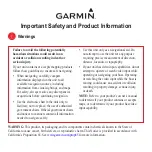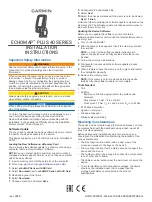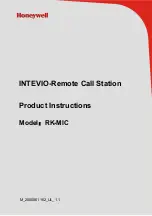
WMS 300
13
4. Switch the transmitter back on by setting the POWER 0/I switch
to I.
5. Screw the battery compartment lid (8) back on CW.
(Tabelle:) Schalter = Switch Kanal = Channel
Important:
Be sure to switch the transmitter off prior to selecting
a different carrier frequency and back on after-
wards. Otherwise, the new carrier frequency will
not be stored.
7.4. Selecting Carrier Frequencies on the PT 300
Bodypack Transmitter
1. If the transmitter is switched on, switch it off by setting the
POWER 0/I switch (17) to 0.
2. Set the frequency selector (22) to the desired frequency (called
a „Channel“ in the carrier frequency table).
Refer to the table on the right to set each DIP switch to the re-
quired position. (The same table is also printed on a sticker
(24) next to the frequency selector (22).)
3. Switch the transmitter back on by setting the POWER 0/I switch
to I.
Important:
Be sure to switch the transmitter off prior to selecting
a different carrier frequency and back on after-
wards. Otherwise, the new carrier frequency will
not be stored.
Note:
Check that the transmitter and receiver are tuned to the same set of
carrier frequencies (labels (11), (25), (35)) and set to the same
carrier frequency.
7.5. Selecting Carrier Frequencies on the SR 300
Receiver
Set the CHANNEL control (33) to the desired carrier frequency
(channel 1 to 16). The opening in the control knob indicates the
selected carrier frequency.
7. Carrier Frequencies
The HT 300 handheld transmitter, PT 300 bodypack transmitter,
and SR 300 receiver have been factory programmed for a maxi-
mum of 16 carrier frequencies. The carrier frequency selectors on
the HT 300 (9), PT 300 (22), and SR 300 (33) each allow you to
select one of these frequencies. The carrier frequency tables on the
transmitters (10), (24) and receiver (41) list all the frequencies
your WMS 300 can be tuned to.
If, due to government regulations, your system provides less than
16 frequencies then the remaining storage locations all contain
the highest of the preset frequencies.
7.1. Sets of Carrier Frequencies
Each set of carrier frequencies has a specific designation (11), (25),
(35).
Be sure to use only transmitters and receivers tuned
to the same set of carrier frequencies.
Otherwise it may be
impossible to tune transmitters and receivers to the same carrier fre-
quency.
7.2. Ordering Transmitters and Receivers
If you want to order additional transmitters or receivers operating on
the same set of frequencies as your original equipment, be sure to sta-
te the designation of your original frequency set (11), (25), (35) and
the serial number of the original device. We need this information to
ensure your new equipment will be compatible with the original units.
7.3. Selecting Carrier Frequencies on the HT 300
Handheld Transmitter
1. If the transmitter is switched on, switch it off by setting the
POWER 0/I switch (7) to 0.
2. Unscrew the battery compartment lid (8) CCW.
3. Set the frequency selector (9) to the desired frequency (called a
„Channel“ in the carrier frequency table). Refer to the table on
the right to set each DIP switch to the required position. (The
same table is also printed on a sticker (10) next to the fre-
quency selector (9).)
8. Setting Up
HT 300 Handheld Transmitter
Mount the microphone element on the HT 300 handheld transmit-
ter referring to section 4.2. „Mounting the Microphone Element
(D 3700 WL, D 3800 WL, C 5900 WL)“.
8.1. Inserting/Replacing and Testing Batteries
Refer to fig. 4.
1. Unscrew the battery compartment lid (8) CCW.
2. Insert the supplied batteries into the battery compartment,
observing the polarity marks (+/-).
3. Set the frequency selector (9) to the desired channel
(carrier frequency) referring to sections 7.1.
„Sets of Carrier Frequencies“ and 7.3. „Selecting
Carrier Frequencies on the HT 300 Handheld Trans-
mitter“.
4. Replace the battery compartment lid over the battery
compartment and screw home CW.
PT 300 Bodypack Transmitter
Connect the microphone or instrument referring to section
5.3. „Connecting and Disconnecting a Microphone or
Instrument“.
8.2. Inserting/Replacing and Testing Batteries
Refer to fig. 5.
1. Unlock the battery compartment door (26) by turning the
locking screw CCW through 90 degrees using a coin.
2. Slide the battery compartment door (26) outward in the direc-
tion of the arrow and open the battery compartment door (26).
3. Insert the supplied 1.5-V battteries into the battery compart-
ment. Make sure to observe the correct polarity. If you insert the
battery with reversed polarity the bodypack transmitter will not
function.
4. Close the battery compartment door (26) and slide it back in-
ward against the direction of the arrow until it clicks shut.














































